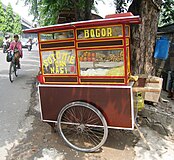 Soto mie bogor style, noodle and rice vermicelli, cabbage, tomato, (cartilage and tendons of cow's trotters) and tripes, risoles spring rolls, served in broth soup, added sweet soy sauce, sprinkled with fried shallots and sambal chilli | |
| Alternative names | Soto mi, Mee soto |
|---|---|
| Course | Main course |
| Place of origin | Indonesia [1] |
| Region or state | Nationwide in Indonesia, also popular in Maritime Southeast Asia |
| Associated cuisine | Indonesia, Singapore, Malaysia |
| Serving temperature | Hot |
| Main ingredients | Chicken, or beef soups with noodle |
| 433 [2] kcal | |
Soto mie, [3] Soto mi, or Mee soto [4] is a spicy Indonesian noodle soup dish [5] commonly found in Indonesia, Malaysia, and Singapore. Mie means noodle made of flour, salt and egg, while soto refers to Indonesian soup. In Indonesia, it is called soto mie and is considered one variant of soto , while in Malaysia and Singapore it is called mee soto.


